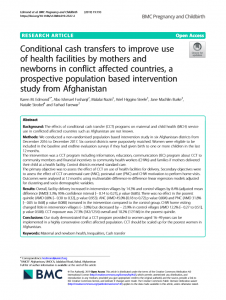
Background
The effects of conditional cash transfer (CCT) programs on maternal and child health (MCH) service use in conflicted affected countries such as Afghanistan are not known.
Methods
We conducted a non-randomised population based intervention study in six Afghanistan districts from December 2016 to December 2017. Six control districts were purposively matched. Women were eligible to be included in the baseline and endline evaluation surveys if they had given birth to one or more children in the last 12 months.
The intervention was a CCT program including information, education, communication (IEC) program about CCT to community members and financial incentives to community health workers (CHWs) and families if mothers delivered their child at a health facility. Control districts received standard care.
The primary objective was to assess the effect of CCT on use of health facilities for delivery. Secondary objectives were to assess the effect of CCT on antenatal care (ANC), postnatal care (PNC) and CHW motivation to perform home visits.
Outcomes were analysed at 12 months using multivariable difference-in-difference linear regression models adjusted for clustering and socio demographic variables.
Results
Overall, facility delivery increased in intervention villages by 14.3% and control villages by 8.4% (adjusted mean difference [AMD] 3.3%; 95% confidence interval [− 0.14 to 0.21], p value 0.685). There was no effect in the poorest quintile (AMD 0.8% [− 0.30 to 0.32], p value 0.953). ANC (AMD 45.0% [0.18 to 0.72] p value 0.004) and PNC (AMD 31.8% [− 0.05 to 0.68] p value 0.080) increased in the intervention compared to the control group. CHW home visiting changed little in intervention villages (− 3.0%) but decreased by − 23.9% in control villages (AMD 12.2% [− 0.27 to 0.51], p value 0.508). CCT exposure was 27.3% (342/1254) overall and 10.2% (17/166) in the poorest quintile.
Conclusions
Our study demonstrated that a CCT program provided to women aged 16–49 years can be implemented in a highly conservative conflict affected population. CCT should be scaled up for the poorest women in Afghanistan.